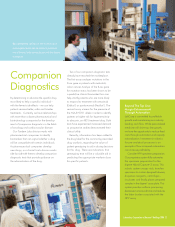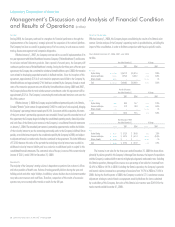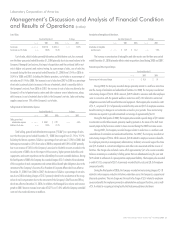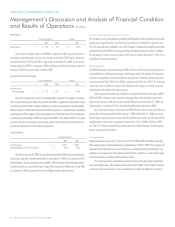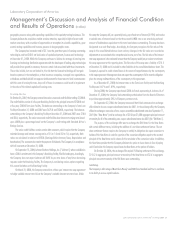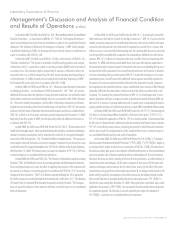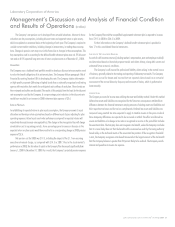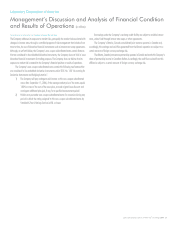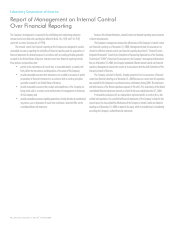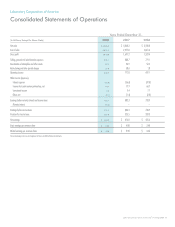LabCorp 2008 Annual Report Download - page 27
Download and view the complete annual report
Please find page 27 of the 2008 LabCorp annual report below. You can navigate through the pages in the report by either clicking on the pages listed below, or by using the keyword search tool below to find specific information within the annual report.Laboratory Corporation of America® Holdings 2008 25
Management’s Discussion and Analysis of Financial Condition
and Results of Operations (in millions)
Laboratory Corporation of America
In December 2007, the FASB issued SFAS No. 160, “Noncontrolling Interests in Consolidated
Financial Statements – an amendment of ARB No. 51.” SFAS No. 160 requires all entities to
report noncontrolling (minority) interests in subsidiaries as equity in the consolidated financial
statements. This Statement is effective for the Company as of January 1, 2009. Earlier adoption
is prohibited. Beginning in 2009, the Company will report minority interests in subsidiaries as
equity in accordance with SFAS No. 160.
In December 2007, the FASB issued SFAS No. 141(R), a revised version of SFAS No. 141,
“Business Combinations.” The revision is intended to simplify existing guidance and converge
rulemaking under U.S. generally accepted accounting principles (GAAP) with international
accounting rules. This statement applies prospectively to business combinations where the
acquisition date is on or after the beginning of the first annual reporting period beginning on
or after December 15, 2008. An entity may not apply it before that date. Beginning in 2009,
the Company will record acquisitions in accordance with SFAS 141(R).
In March 2008, the FASB issued SFAS No. 161, “Disclosures about Derivative Instruments
and Hedging Activities – an amendment of FASB Statement No. 133.” SFAS 161 requires
additional disclosures about the objectives of using derivative instruments, the method by which
the derivative instruments and related hedged items are accounted for under FASB Statement
No. 133 and its related interpretations, and the effect of derivative instruments and related
hedged items on financial position, financial performance, and cash flows. SFAS 161 also requires
disclosure of the fair values of derivative instruments and their gains and losses in a tabular format.
SFAS 161 is effective for fiscal years and interim periods beginning after November 15, 2008.
Beginning in the first quarter of 2009, the Company will provide the additional disclosures in
accordance with SFAS 161.
In April 2008, the FASB issued FASB Staff Position No. FAS 142-3, “Determination of the
Useful Life of Intangible Assets,” which amends the factors that should be considered in developing
renewal or extension assumptions used to determine the useful life of a recognized intangible
asset under FASB Statement No. 142, “Goodwill and Other Intangible Assets.” This pronounce-
ment requires enhanced disclosures concerning a company’s treatment of costs incurred to renew
or extend the term of a recognized intangible asset. FSP 142-3 is effective for fiscal years beginning
after December 15, 2008. The Company does not expect the adoption of FSP 142-3 will have
a material impact on its consolidated financial statements.
In May 2008, the FASB issued SFAS 162, “The Hierarchy of Generally Accepted Accounting
Principles.” SFAS 162 identifies the sources of accounting principles and the framework for selecting
the accounting principles to be used. Any effect of applying the provisions of this statement will
be reported as a change in accounting principle in accordance with SFAS No. 154, “Accounting
Changes and Error Corrections.” SFAS 162 is effective sixty days following the SEC’s approval of
the Public Company Accounting Oversight Board amendments to AU Section 411, “The Meaning
of Present Fairly in Conformity With Generally Accepted Accounting Principles.” The Company
does not expect the adoption of this statement will have a material impact on its consolidated
financial statements.
In May 2008, the FASB issued Staff Position No. APB 14-1, “Accounting for Convertible
Debt Instruments that May be Settled in Cash Upon Conversion.” APB 14-1 requires that the
liability and equity components of convertible debt instruments that may be settled in cash upon
conversion (including partial cash settlement) be separately accounted for in a manner that
reflects an issuer’s nonconvertible debt borrowing rate. The resulting debt discount is amortized
over the period the convertible debt is expected to be outstanding as additional non-cash interest
expense. APB 14-1 is effective for financial statements issued for fiscal years beginning after
December 15, 2008, and interim periods within those fiscal years. Retrospective application to
all periods presented is required except for instruments that were not outstanding during any of
the periods that will be presented in the annual financial statements for the period of adoption
but were outstanding during an earlier period. APB 14-1 impacts the Company’s zero-coupon
subordinated notes, and will require that additional interest expense essentially equivalent to
the portion of issuance proceeds retroactively allocated to the instrument’s equity component
be recognized over the period from the zero-coupon subordinated notes’ issuance in 2001 through
September 2004 (the first date holders of these notes had the ability to put them back to the
Company). The Company has evaluated the impact of APB 14-1 and anticipates that its retro-
spective application will have no impact on results of operations for periods following 2004, but
will result in an increase in opening additional paid-in capital and a corresponding decrease in
opening retained earnings, net of deferred tax impacts, on post-2004 consolidated balance sheets.
In October 2008, the FASB issued FASB Staff Position No. FAS 157-3, “Determining the
Fair Value of a Financial Asset When the Market for That Asset Is Not Active” (“FSP 157-3”).
FSP 157-3 clarified the application of SFAS No. 157 in an inactive market. It demonstrated how
the fair value of a financial asset is determined when the market for that financial asset is inactive.
FSP 157-3 was effective upon issuance, including prior periods for which financial statements
had not been issued. The implementation of this standard did not have a material impact on
our consolidated financial position and results of operations.
In December 2008, the FASB issued FASB Staff Position No. FAS 132(R)-1, “Employers’
Disclosures about Postretirement Benefit Plan Assets” (“FSP 132(R)-1”). FSP 132(R)-1 applies to
an employer that is subject to the disclosure requirements of SFAS No. 132(R). The objectives of
the disclosures about plan assets in an employers’ defined benefit pension or other postretirement
plan are to provide users of financial statements with an understanding of: (1) how investment
allocation decisions are made, including the factors that are pertinent to an understanding of
investment policies and strategies, (2) the major categories of plan assets, (3) the inputs and
valuation techniques used to measure the fair value of plan assets, (4) the effect of fair value
measurements using significant unobservable inputs (Level 3) on changes in plan assets for the
period, and (5) significant concentrations of risk within plan assets. An employer should consider
those overall objectives in providing detailed disclosures about plan assets. FSP 132(R)-1 is
effective for years ending after December 15, 2009. Early application is permitted. Upon initial
application, the provisions of FSP 132(R)-1 are not required for earlier periods that are presented
for comparative periods. The Company is currently evaluating the impact the adoption of
FSP 132(R)-1 could have on its consolidated financial statements.


